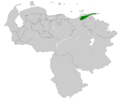Sucre antpitta facts for kids
Quick facts for kids Sucre antpitta |
|
|---|---|
| Conservation status | |
| Scientific classification | |
| Genus: |
Grallaricula
|
| Species: |
cumanensis
|
 |
|
The Sucre antpitta (Grallaricula cumanensis) is a small, shy bird found in the mountains of Venezuela. It belongs to a group of birds known as antpittas, which are famous for their unique calls and secretive lives on the forest floor. This particular antpitta is named after the Sucre region in Venezuela where it lives.
Contents
What is an Antpitta?
Antpittas are a type of bird that mostly live in Central and South America. They are known for their short tails, long legs, and plump bodies. Many antpittas spend their time on the ground, hopping through the undergrowth of forests. They often have loud, clear calls that help them communicate in their dense habitats.
The Grallariidae Family
The Sucre antpitta is part of the Grallariidae family. This family includes many different kinds of antpittas. Scientists group animals into families based on their shared features and how they are related. The Grallariidae family is known for its members' distinct appearance and behavior, especially their ground-dwelling habits.
Where Does the Sucre Antpitta Live?
The Sucre antpitta lives only in a specific area called the Venezuelan Coastal Range. This is a chain of mountains along the northern coast of Venezuela. It prefers to live in moist montane forests, which are forests found in mountainous regions. These forests are often cloudy and wet, providing a perfect home for many unique plants and animals.
Its Natural Habitat
The natural habitat of the Sucre antpitta is very important for its survival. It needs these specific moist montane forests to find food, build nests, and raise its young. The dense trees and undergrowth offer protection from predators and the elements. Protecting these forests is key to protecting the Sucre antpitta.
What Does the Sucre Antpitta Look Like?
Like other antpittas, the Sucre antpitta is a small bird. It has a rounded body, relatively long legs, and a short tail. Its coloring helps it blend into the forest floor, making it hard to spot. While specific details of its appearance might vary, antpittas generally have earthy tones of brown, olive, and gray.
Why Is the Sucre Antpitta Important?
Every species plays a role in its ecosystem, and the Sucre antpitta is no exception. As a part of the forest food web, it helps control insect populations. Its presence also indicates a healthy forest environment. When a species like the Sucre antpitta is in trouble, it often means its habitat is also facing threats.
Conservation Status
The Sucre antpitta is currently listed as "Vulnerable" (VU) by the IUCN. This means that it faces a high risk of extinction in the wild. The main reason for its vulnerable status is the loss and damage of its forest habitat.
Threats to Its Survival
The biggest threat to the Sucre antpitta is deforestation. Forests in the Venezuelan Coastal Range are being cleared for farming, logging, and other human activities. This reduces the amount of space the birds have to live and find food. Climate change may also affect its habitat by changing temperature and rainfall patterns.
What Can Be Done?
Protecting the Sucre antpitta involves protecting its forest home. Conservation efforts focus on creating protected areas and working with local communities to promote sustainable land use. Raising awareness about this unique bird and its habitat is also important to encourage conservation.
Images for kids



